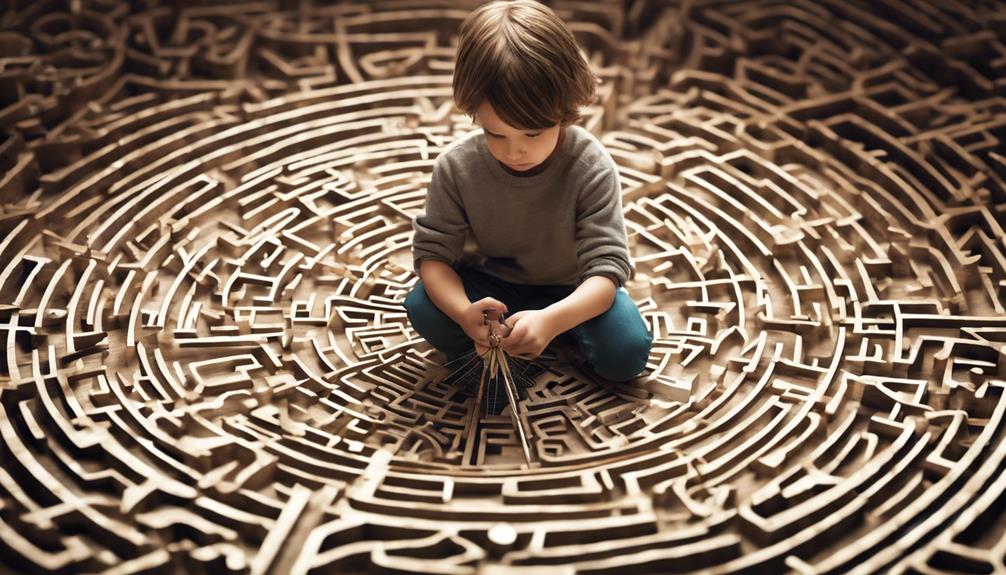As caregivers, we frequently encounter unforeseen obstacles that can have an effect on our children’s well-being.
When navigating divorce and step-parent dynamics, it can be crucial to equip our children with the tools they need to adapt and thrive in the face of change.
By exploring practical strategies and fostering resilience in our children, we can help them navigate these complex family transitions with confidence and grace.
Key Takeaways
- Encourage honest sharing of feelings to foster emotional well-being.
- Establish clear expectations and boundaries for stability and security.
- Develop resilience through problem-solving skills and support networks.
- Nurture positive relationships with parents and build a strong support system.
Understanding the Impact of Divorce
As children of divorced parents, we often find ourselves navigating a world filled with emotional challenges stemming from anxiety and depression. Divorce can shake the very foundation of our lives, leaving us feeling insecure and lost. These feelings can manifest in various ways, impacting our academic performance and overall well-being.
The stress of divorce may lead to behavioral issues as we struggle to cope with the changes happening around us. Additionally, studies suggest that children of divorce may face relationship difficulties later in life, stemming from the early experiences of separation.
It's essential for us to acknowledge the impact of divorce on our lives and recognize that it's okay to feel overwhelmed at times. Seeking support from trusted individuals, such as family members, friends, or counselors, can help us navigate these challenging emotions. By understanding the effects of divorce on our mental health and relationships, we can begin to address these issues and work towards healing and resilience.
Communicating Openly With Parents

We know that open communication can be challenging during times of divorce or when dealing with step-parent challenges. Encouraging your child to share their feelings honestly with both parents can help foster understanding and empathy.
Creating a safe and non-judgmental environment where your child can express their concerns freely is essential for their emotional well-being.
Honest Parent-Child Talks
When engaging in honest parent-child talks, it's crucial to create a safe and open environment where feelings and concerns can be freely expressed and understood. Here are four essential ways to support your child through open communication during divorce and step-parent challenges:
- Listen Actively: Validate your child's emotions and provide reassurance.
- Be Transparent: Address any questions about divorce and step-parent relationships honestly.
- Build Trust: Create a safe space for your child to share their thoughts without judgment.
- Regular Check-Ins: Ensure your child feels supported and informed throughout the process.
Clear Expectations Set
Setting clear expectations with parents is essential for children to feel secure and understand their roles in navigating challenges during divorce and step-parenting. It's crucial to openly communicate about responsibilities, boundaries, and roles to provide children with a sense of stability and trust in changing family dynamics. Here's a helpful table outlining the importance of setting clear expectations:
| Benefits of Clear Expectations | Impact on Children |
|---|---|
| Promotes stability | Helps children feel secure |
| Builds trust | Understand their roles better |
| Reduces confusion | Decreases anxiety levels |
| Establishes boundaries | Fosters healthy communication |
Active Listening Skills
Navigating divorce and step-parent challenges can be eased by honing active listening skills, ensuring open and empathetic communication with parents. To communicate openly with parents, consider:
- Pay Attention: Fully concentrate on what your parent is saying without interruptions.
- Read Cues: Notice both verbal and nonverbal cues to understand their message accurately.
- Reflect Back: Repeat what your parent says to show understanding and promote open communication.
- Ask Questions: Clarifying questions demonstrate interest and deepen conversations with parents.
Establishing Healthy Boundaries

Establishing healthy boundaries in a blended family is essential for fostering a sense of security and promoting harmonious relationships among children and step-parents. Boundaries play a crucial role in creating a safe environment where children can navigate the complexities of blended families with respect and understanding.
By setting clear expectations, boundaries provide stability and help children express their needs effectively. They also contribute to developing healthy relationships with step-parents and siblings. Teaching children to communicate boundaries not only fosters mutual respect but also encourages harmonious interactions within the family.
Early establishment of healthy boundaries in a blended family can lead to smoother transitions and stronger family dynamics over time. It's important to remember that boundaries aren't barriers but rather tools that enhance understanding and facilitate positive connections within the family unit.
Building Relationships With Step-Parents

Building a strong and trusting relationship with a step-parent requires patience, open communication, and a willingness to cultivate mutual respect. It's normal to feel uncertain or even resistant when blending families, but with time and effort, a loving connection can blossom. Here are some tips to help nurture this important relationship:
- Establish Boundaries: Clearly define boundaries and expectations from the beginning to create a healthy dynamic with your step-parent.
- Include Them in Family Activities: Involving your step-parent in family outings and discussions can help them feel like a valued part of the family unit.
- Offer Support and Acknowledgment: Show appreciation for your step-parent's efforts and offer your support as they navigate their role. Acknowledging their contributions can strengthen the bond between you.
- Work Together to Strengthen the Bond: Through shared experiences, open conversations, and mutual respect, you can build a strong and lasting connection with your step-parent.
Seeking Emotional Support

When supporting a child through divorce and step-parent challenges, it's crucial to prioritize their emotional well-being by encouraging open expression of feelings and seeking additional support resources like therapy or counseling. It's essential to create a safe space where your child feels comfortable sharing their emotions without judgment. Encourage them to express their feelings openly, whether it's through talking, drawing, or writing. Seeking therapy or counseling can provide them with professional guidance and a supportive environment to navigate the changes they're experiencing.
In addition to professional help, promoting emotional well-being can also involve engaging in activities like art therapy, journaling, or mindfulness exercises. Encourage your child to build a support network with trusted friends, family members, or support groups. Having a circle of understanding individuals can offer different perspectives and emotional support. Remember to validate your child's emotions, letting them know that what they feel is valid and important in their journey through divorce and step-parent challenges.
Developing Coping Strategies

To help your child navigate the challenges of divorce and step-parenting, let's explore effective coping strategies together.
- Encourage Expression: It's essential to encourage your child to express their feelings. Whether through art, journaling, or talking to a trusted adult, providing outlets for emotional release can help them process their emotions in a healthy way.
- Establish Routine: Helping your child establish a routine can provide much-needed stability and predictability during times of change. Routines offer a sense of security and help children feel more in control amidst the disruptions caused by divorce and step-parenting.
- Teach Problem-Solving Skills: Equipping your child with problem-solving skills is crucial. These skills won't only help them navigate the challenges that come their way but also build resilience in the face of adversity.
- Foster Positive Relationships: Supporting your child in maintaining positive relationships with both biological and step-parents is vital. Encouraging healthy interactions and open communication can help create a supportive environment for your child to thrive despite the challenges they may be facing.
Embracing Change With Resilience

Navigating through the challenges of divorce and step-parenting can be overwhelming, but embracing change with resilience is key to helping children thrive in these shifting family dynamics. Resilience in children during divorce leads to better emotional outcomes and coping skills. Encouraging adaptability helps them navigate changes in family dynamics with ease. Building a support network enhances their resilience and ability to adjust, while teaching problem-solving skills empowers them to face challenges in divorce and blended families. Embracing change with resilience fosters a positive mindset and emotional well-being in children. It's important to remember that children are remarkably adaptable and can thrive when provided with the right support and tools to navigate these changes. By fostering resilience, problem-solving skills, and a positive outlook, children can embrace change and emerge stronger from the complex emotions and adjustments that come with divorce and step-parent challenges.
| Keywords | Description |
|---|---|
| Resilience | Key for better emotional outcomes and coping skills in children during divorce. |
| Adaptability | Helps children navigate changes in family dynamics with ease. |
| Support Network | Enhances children's resilience and ability to adjust to new family situations. |
| Problem-Solving | Empowers children to face challenges in divorce and blended families. |
Frequently Asked Questions
At What Age Is a Child Most Affected by Divorce?
We believe children between 8 and 12 can be profoundly impacted by divorce due to their cognitive and emotional development. They may struggle with loyalty conflicts, guilt, and responsibility, requiring extra support and understanding to navigate challenges effectively.
How Can a Child Overcome Divorce?
We believe children can overcome divorce by fostering open communication, providing reassurance, maintaining stability, validating their emotions, and seeking professional support when needed. Remember, they are resilient and with love and guidance, they can thrive.
What Is the Best Custody Arrangement for Children?
We believe the best custody arrangement for children involves ensuring they have meaningful relationships with both parents, fostering emotional stability, and supporting their overall well-being. Balancing time between both parents can lead to better outcomes post-divorce.
How Do Children Typically Manage Divorce?
We manage divorce by experiencing a whirlwind of emotions like shock, anger, and grief. Kids often feel lost in the chaos, needing understanding and reassurance. Encouraging open communication helps us navigate the challenges and find our way through.
Conclusion
In conclusion, by understanding the impact of divorce, communicating openly with parents, establishing healthy boundaries, building relationships with step-parents, seeking emotional support, developing coping strategies, and embracing change with resilience, children can navigate divorce and step-parent challenges successfully.
Let's support our children through these transitions, listen to their feelings, and create a safe space for them to thrive.
Together, we can help them adjust and build strong, loving relationships in their blended families.










